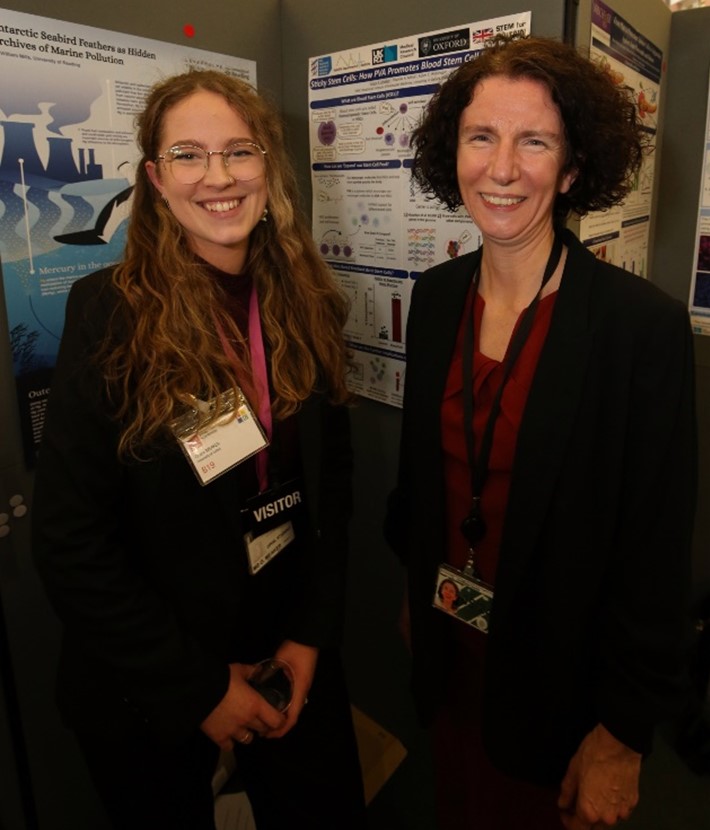Grace Meaker, University of Oxford, UK
The Physiological Society Prize winner at STEM for Britain 2024
Grace Meaker specialised in genetics during her undergraduate studies, which led to her interest in the translational applications of blood stem cells. Devoting her PhD to this study, Grace tells us about her project growing blood stem cells in the lab, for which she was awarded The Physiological Society Prize at STEM for Britain 2024.
I completed my undergraduate studies at Cardiff University, UK, including a sandwich year in Thomas Gorochowski’s lab at the University of Bristol, UK. It was during this time that I witnessed the power of CRISPR gene-editing and became keen on pursuing an independent research project on it. With a desire to apply CRISPR in translational and potentially medical contexts, I found the perfect fit for my PhD at the MRC Weatherall Institute of Molecular Medicine, University of Oxford, UK.
Boosting blood stem cell production
I was fortunate to be the first PhD student in my lab, so I received direct training from a pioneer in the haematology and stem cell field, my supervisor Dr Adam Wilkinson. Dr Wilkinson had developed a novel method to grow blood stem cells during his postdoc and helped me to apply it to explore how blood stem cells are regulated. The findings could be used to help improve treatment options for people living with blood disorders. His guidance and support, along with my second supervisor Professor Tom Milne, have been invaluable to me throughout my PhD journey.
Stem cells offer life-saving treatment
My project focuses on blood stem cells which are important for human health as they provide cells for the blood and immune system. Despite their importance, they are scarce with just ~1:30,000 in the adult bone marrow. Therefore, studying their biology has proven difficult.
Understanding the biology of blood stem cells will inform allogeneic bone marrow transplants, a mainstay treatment for blood disorders such as leukaemia where healthy blood stem cells are transplanted from a donor to the patient. Blood stem cells can also be isolated from umbilical cord blood, offering an alternative to marrow-derived blood stem cells. Umbilical cord blood stem cells require less stringent genetic matching, which can help patients find a stem cell donor match. A process that can be hard and long given the specificity of the stem cell genetic marker which needs to be identical, or have slight variation, between donor and recipient.
This clinical potential has piqued researchers’ interest. However, umbilical cord blood contains far fewer blood stem cells than those derived from bone marrow and there are often insufficient numbers for a viable transplant. Attention is now focused on growing umbilical cord blood stem cells in the lab to overcome this problem by providing plenty of blood stem cells to boost the population of blood cells for transplantation.

Searching for novel stem cell genes
In the lab, we are using Dr Wilkinson’s method that uses a polymer called PVA (like in the glue) to grow blood stem cells by approximately a thousand-fold. We can then edit the genetic material of the stem cells to understand how they are regulated. This is a significant development in blood stem cell research because it allows us to perform complex experiments which require many cells. I am searching for gene regulators that control blood stem cell activity. Identifying these genes will help us to develop new strategies to improve the ability of blood stem cells to repopulate the blood system quickly following transplantation.
By applying a large-scale CRISPR genetic screening technique to blood stem cells, we identified a group of genes we hadn’t previously known regulated blood stem cell activity. Using gene editing, we stopped (knocked out) one such gene functioning in blood stem cells and found that it increased blood system repopulation by approximately five-fold. This could be a promising approach to help maximise the number of blood stem cells derived from umbilical cord blood, which could make it a more viable option for transplants.
My PhD project has been so rewarding, having the chance to work with this fascinating and complex stem cell type and the ground-breaking CRISPR gene-editing system is the perfect blend of my interests. I have also had the opportunity to present my work in the UK and abroad, and to network with top scientists for which I am immensely grateful.
Tackling present and future health challenges
I applied for STEM for Britain because I am passionate about science communication and believe it is crucial to share our work with policy makers and influential figures in scientific institutions such as The Physiological Society. Sustaining dialogue between scientists and politicians is vital for addressing present and future global challenges. I was honoured to be invited to present a poster, and winning The Physiological Society prize this year was truly gratifying. This acknowledgment of my work and love of science communication meant so much to me.
It was also a proud moment for our institute, as four of the thirty finalists in Biology and Biomedical Sciences were from the Weatherall Institute of Molecular Medicine! I would recommend STEM for Britain to anyone interested in developing their presentation skills for a lay audience while also gaining insight into the amazing science happening around the UK.

See our news article published soon after Grace was presented The Physiological Society Prize for her poster ‘Sticky Stem Cells: How PVA promotes blood stem cell production’ to find out more about the judging panel and the Parliamentary event.
